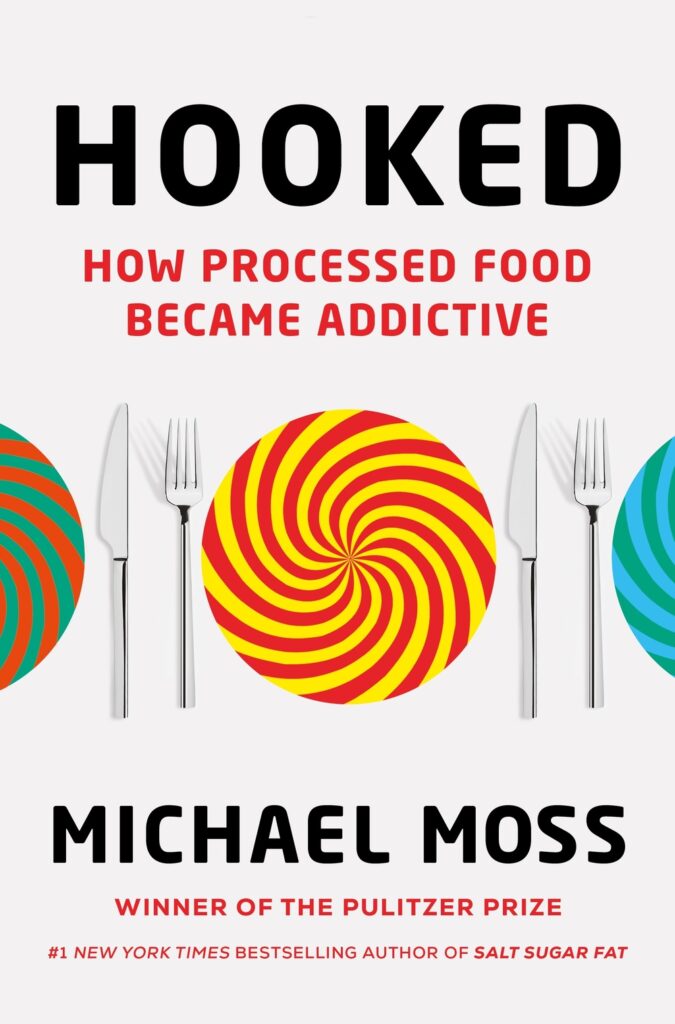Sharing my learnings from the book, Hooked by Michael Moss
Hooked by Michael Moss
Everyone knows how hard it can be to maintain a healthy diet. But what if some of the decisions we make about what to eat are beyond our control? Is it possible that food is addictive, like drugs or alcohol? And to what extent does the food industry know, or care, about these vulnerabilities? In Hooked, Pulitzer Prize–winning investigative reporter Michael Moss sets out to answer these questions—and to find the true peril in our food.
Moss uses the latest research on addiction to uncover what the scientific and medical communities—as well as food manufacturers—already know: that food, in some cases, is even more addictive than alcohol, cigarettes, and drugs. Our bodies are hardwired for sweets, so food giants have developed fifty-six types of sugar to add to their products, creating in us the expectation that everything should be cloying; we’ve evolved to prefer fast, convenient meals, hence our modern-day preference for ready-to-eat foods. Moss goes on to show how the processed food industry—including major companies like Nestlé, Mars, and Kellogg’s—has tried not only to evade this troubling discovery about the addictiveness of food but to actually exploit it. For instance, in response to recent dieting trends, food manufacturers have simply turned junk food into junk diets, filling grocery stores with “diet” foods that are hardly distinguishable from the products that got us into trouble in the first place. As obesity rates continue to climb, manufacturers are now claiming to add ingredients that can effortlessly cure our compulsive eating habits.
A gripping account of the legal battles, insidious marketing campaigns, and cutting-edge food science that have brought us to our current public health crisis, Hookedlays out all that the food industry is doing to exploit and deepen our addictions, and shows us why what we eat has never mattered more.

- Yale graduate student Ashley Gearhardt was studying our relationship with food in 2007. Ultimately, Gearhardt concluded that a whopping 15 percent of the American population met the criteria for being addicted to food. What’s more, most of them were severely addicted. These people were overconsuming certain types of food and were losing control. They couldn’t stop eating – even when they wanted to.
- Scientists have concluded that some people’s brains respond in the same way to junk food as they would to addictive drugs. In both cases, their brains shout “This is good, I want more!”
- Your brain controls your appetite but addiction can control your brain.
- scientists believe that addiction hinges on how fast a substance can get into your bloodstream and travel to your brain. The quicker a substance can travel, the more addictive it is. Disturbingly, sugar, salt, and fat – the hallmarks of processed foods – only take about half a second to start affecting your brain.
- Your childhood eating habits are still affecting you today. When you have an exciting or stimulating experience, your brain creates a permanent memory of it. That memory is stored as a neural pathway; a physical connection between two neurons in your brain. Every time you have that experience again, or even think about it, the neural pathway is strengthened. This makes it easier for you to think about that memory in the future.
- the dawn of human evolution was one of extremes; the climate swung between very hot and very cold. In order to survive, our ancestors evolved to eat and enjoy a wide variety of foods. But while this love for variety served our ancestors well, today it’s encouraging us to overeat.
- your stomach is programmed to like calorie-dense foods. That’s partly why processed foods like four-cheese pizzas and double-stuff Oreos are so pleasurable to eat. It’s not just that they taste good in your mouth, they taste good in your stomach too, purely because they’re so dense in calories.
- Enter the processed food industry and its new solution to this problem: convenience foods. These foods took all the work out of food preparation. When busy families tucked into their conveniently microwaved pizzas, or enchiladas, or pot pies, they didn’t know exactly what ingredients their new food contained. If they’d known, they might have been more cautious.
- our appetite is controlled by two distinct parts of our brains, which some neuroscientists call the go brain and the stop brain.
- The go brain encourages us to eat
- the stop brain kicks in when we’ve had enough
- the processed food industry has come up with a way to override this delicate system. It’s called the bliss point, and it describes the exact point at which a product becomes so sugary, and our brains get so excited by eating it, that our stop system is disabled. When this happens, we mindlessly eat, and eat, and eat.
- the problem may be that your digestive system cannot calculate how many calories there are in highly-processed foods. Whenever you eat a meal, your stomach can accurately judge how many calories the meal contains. Your body then uses this information to decide how many to store as fat, and how many to burn off through your metabolism. So, if your body can’t calculate how many calories are in a meal, then your metabolism can’t function properly, and too many calories are stored as fat.


Leave a Reply